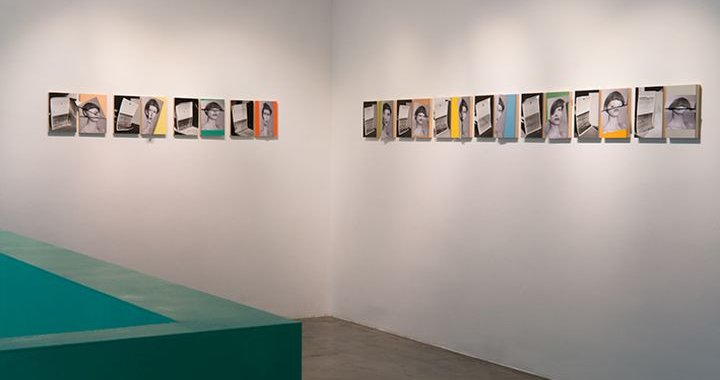
“Art is hard work”
Annika Toots
10/05/2014
Sigrid Viir graduated from the department of photography at the Estonian Academy of Arts. She has worked on numerous solo art projects, and is also an active member of the artist group Visible Solutions LLC; the group took part in the 9th Manifesta Biennaale in Genk, Belgium. As an artist, Viir is especially intrigued by social agreements, moral norms and rules that serve as our “daily tools“ by default, the tools that have been automatically accepted and utilized in our society in order to function. Sigrid Viir uses the elements of photography, installation and video in her artwork. In 2011 she was nominated for the Köler Art Prize; in 2012 she was awarded the annual art prize of the Cultural Endowment of Estonia.
When I arrive at the Hobusepea Gallery, she is still finishing painting the funnel in her painting suit. She does this every day during the exhibition, and each day is a new color. I ask her how long does it take to paint the funnel, and she answers that together with cleaning up, it takes around three hours each day. “It’s hard work,” she says. However, it’s part of the artwork – the artwork is the process.
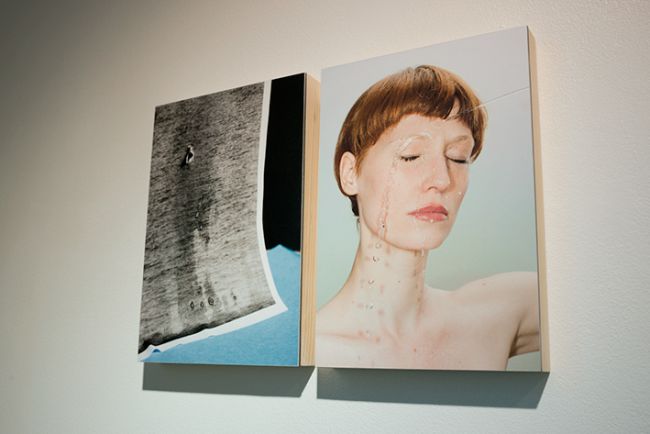
From the Purpose of the Universe and the Flickering Funnel exhibition at Hobusepea gallery
She is known for using photography and installation to face the collective norms of society and to deconstruct our daily way of life. She points out the things that we usually pay no attention to. This time, it is her daily life as an artist that is under deconstruction. It is personal, yet it is generally relevant. It is also her first solo exhibition and she introduces it with a poem:
Nothingness is the grease of all things,
we are water jerricans
by ourselves
all in a different package,
we swam a long way before landing
in cities of colourful signs,
where one had better stand up
to see further
or to climb the pedestal
or the mountain top,
to conquer,
to be driven to success,
sportive,
sweaty tears of shame rapidly flowing against the current
along the armpits,
the invisible antiperspirant stick in the handbag,
performance is not yet everything,
primariness can be changed,
the dark horizon of a vague future is not the worst thing,
one can get used to it,
as usual
circulation
create
throwing
loop
the futile purpose copulating with the universal nothingness,
the purpose of a gobbled-up universe idling on the edge of a flickering funnel.
/Sigrid Viir/
What is the main idea behind your exhibition, “Purpose of the Universe and the Flickering Funnel”?
In a way, this poem (or this collection of keywords that I wrote) is the title of the exhibition. In fact, this is a second, more specifying title of the exhibition. This poem comes partly from the same system that I’m in – the system of being an artist. However, it is also about evaluating and measuring our everyday lives. It’s the question of productivity, which seems to be really important and even overemphasized. Everything is being measured and labeled, and this is something that is a little difficult to do with art, which needs different tools for measuring; or maybe there is no point to measure it at all, or rather – some things cannot be explained with words, or they have no explanation, yet.
When I read this poem, I felt like there was a kind of frustration in it. Is there?
Well, maybe a little. It’s just this kind of time. Making art is hard. For the first time, I’m doing everything by myself and there are so many things that you need to do: you need to be the project manager, the accountant, etc. But the exhibition is not directly depressive or frustrated. It is there, but for me, there are also many other layers.
Where did you get the idea of the funnel, and what does it mean to you?
The funnel is like an upside-down pyramid. It seems to be that in this system, the artist is at the bottom of the pyramid. If we are talking about finances, it is normal, for example, that a workman in the gallery or the curators get paid. But the artist is in the last position, the artist is at the bottom of the funnel. However, “flickering funnel” means that this position is not fixed; I imagine it being a sort of rotary funnel – there is a moment of hope there.
Your poem also talked about being at the top, being on the pedestal, and being sportive – in my mind, this is connected with all kinds of art prizes – are these, in a way, the glamorous top of the art-world pyramid?
This glamor is necessary for attention. The prizes are an important way to make the art more popular. To engage with the viewers and to build adrenaline. People can participate and vote, and they are anxious to know who’s going to win. These competitions bring attention to art.
Your installation also consist of a series of self-portraits which you have distorted by folding the paper. How does this relate to the whole idea about the work of the artist?
There’s quite a lot of self-irony in it. I think irony is something that helps you get through everything. It’s healthy to be able to laugh at oneself. In these portraits, the folding symbolizes, in a way, my fear of doing my first solo exhibition and making art. It is quite a great responsibility. There is also the idea of a creative outburst in this series, or rather, I’m making fun of this idea. And the different colors of the funnel are the same as the backgrounds of the portraits which, in turn, come from the outburst images.
There is also a gray sculptural object that is part of the installation, and which I almost didn’t notice the first time I visited the show.
This is the pedestal-cupboard sculpture. It is a monument for myself and it’s about making fun of the aspect of productivity. It is like a cupboard in a sports locker room, and I keep my painting suit in it. So, I use it, but at the same time, it is part of the installation.
In the exhibition there are things that are pretty straight-forward, but then there are other layers as well. The measuring and evaluating of the work of an artist is a problem that everyone knows, and everyone’s talking about it. Sometimes it seems that the best way is to say things directly. However, at same time, you can’t complain because no one is forbidding you to do something else instead of art.
What is it that inspires you to continue doing art, even though it is hard work and maybe doesn’t alway have the position that it should?
I like to think that being an artist is about noticing the details and pointing them out, or then turning them upside down to emphasize or test or to invent something new, and I think I am good at that.
Everyday life inspires me, and the sources for inspiration are quite different.
What is the source in the case of this exhibition?
It seems to me that the inspiration for this show came from my daily life. The exhibition is about the same system that I’m part of. Inspiration can come from something positive, something neutral, or something that irritates you. For example, you get angry if you don’t get the full amount of the grant from The Cultural Endowment that you applied for. And you have to rethink everything, and that takes so much time. This sort of situation can also be a driving force behind an exhibition.
It’s quite peculiar how the viewer is greeted by a row of colorful canisters and the colorful funnel, and it all seems to be quite joyful, but then you realize that the issue of productivity in art and the creative processes are actually hidden in it.
When I’m painting there, people enter the gallery very cautiously, or they only open the door a little bit and leave when they see that I'm painting – because no one is used to seeing the artist working. People are used to seeing a finished work – except for performance art or some other forms of art in which the processes are visible – but usually, they don’t see an artist at work. People have an idea of a builder working, or a baker working, but the way an artist works has remained a somewhat romantic myth – that the artist just sits there and the creativity bursts out of him or her, and it feels great. The problem is to make it understandable that artist’s work is also hard work. But I didn’t want to deal with this issue too directly and complain. Complaining doesn’t help.
What do you see as a solution? How can the artist’s position change for the better in society?
Then again, maybe it is necessary to complain more, to be more vocal. Articulation is important – so that it wouldn’t seem like complaining, but rather more like addressing the issue and explaining it.
You have said that this exhibition is also about the creative processes and how these have somehow remained in the state of a romantic myth. How do you describe your creative process?
It’s about being on the road, wandering and moving around; at those times you see things that you haven’t thought of. The unexpected things are very important. And you have to try things. For example, while building this cupboard, I argued with my father who said that you can’t put concrete and plywood together – that is not how it is done! But you try and you invent something new. Art has a very specific aspect of inventing things.
Building things – creating installations – this seems something that you enjoy doing?
Yes, it’s something that I like to do. I like the idea of a photograph coming down from the wall and entering the room. It must be a certain way of thinking. I enjoy creating things with my hands; I think it is also an extension of thinking.
While going to the latest shows by Estonian photographic artists, I have noticed that the photograph has a tendency to evolve into room-installations. This is partly connected to certain artistic ideas in the photography department at the Academy of Arts. But could it also be that a photograph, as such, has been exhausted? There is too much visual imagery surrounding us, and now everyone is doing room-installations and sculpture instead.
I guess that creating a room is an easier way to bring your idea, or a concept, to life. You have more nuances to play with. It’s not that a photograph alone could not convey the ideas, but it’s also an advanced form of communicating with the viewer. The room surrounding the work fixed on the wall helps create a place for the viewer where he or she can think along with the artist.
And it’s also due to the fact that visual material is everywhere, it’s part of the surroundings. And then there are the 3D printers, etc. Maybe this is why we already think about photographs spatially. It is no longer just flat.
Now that you have opened your personal exhibition, are you thinking about your next creative processes?
We have some unfinished things with Visible Solutions LLC, and we’ll start working on that. And then in August we have a show with Kristiina Hansen and Johannes Säre at Haapsalu Linnagalerii. Actually, the work of an artist takes place 24/7 – you are always thinking about new projects or the unfinished ones.
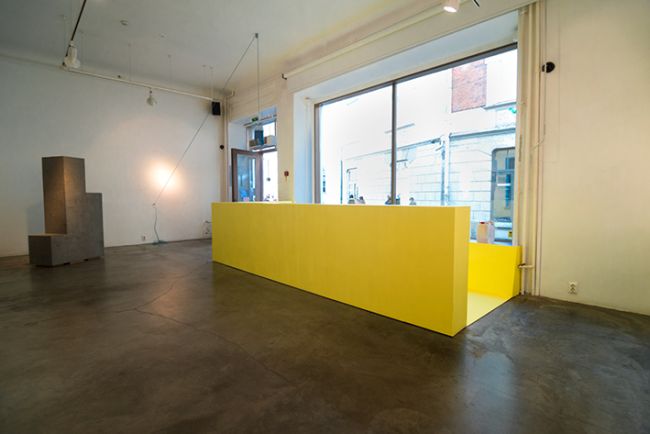
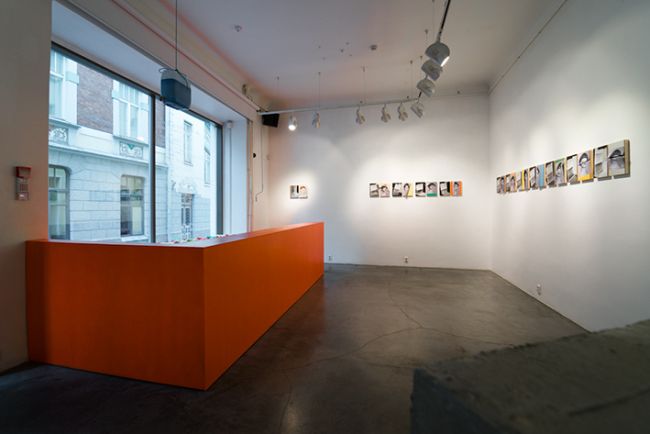
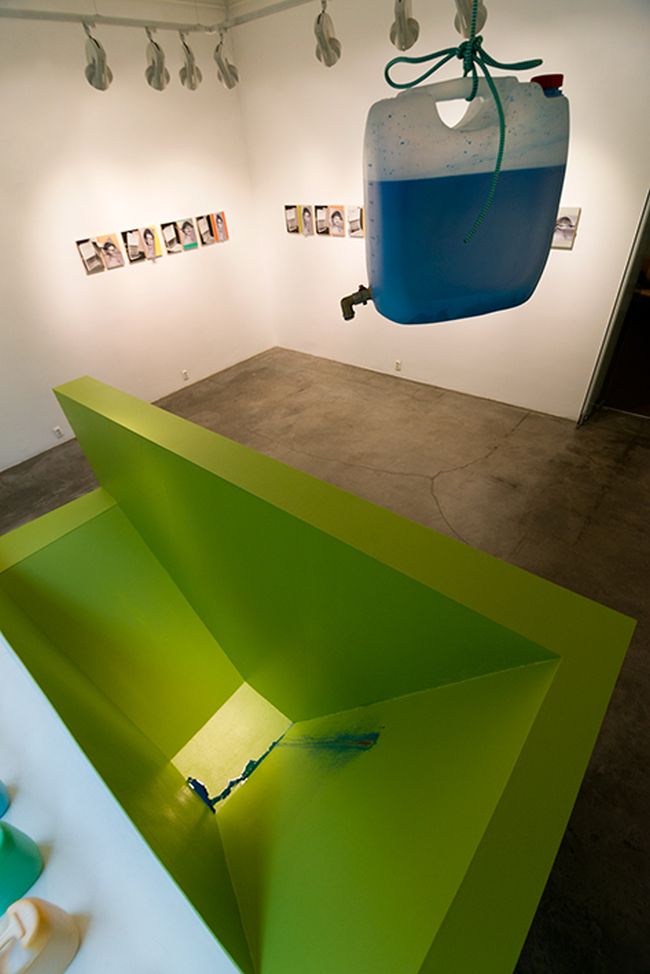
From the Purpose of the Universe and the Flickering Funnel exhibition at Hobusepea gallery